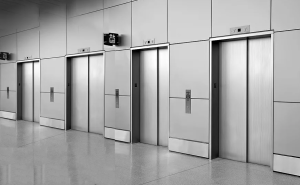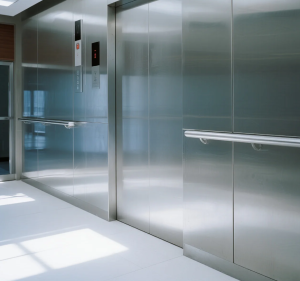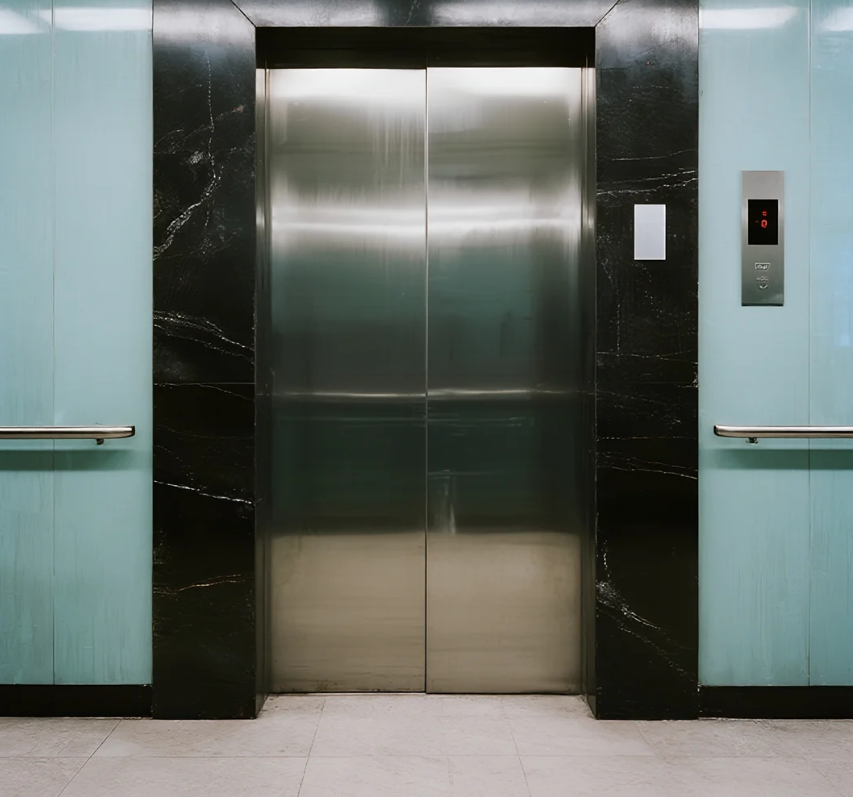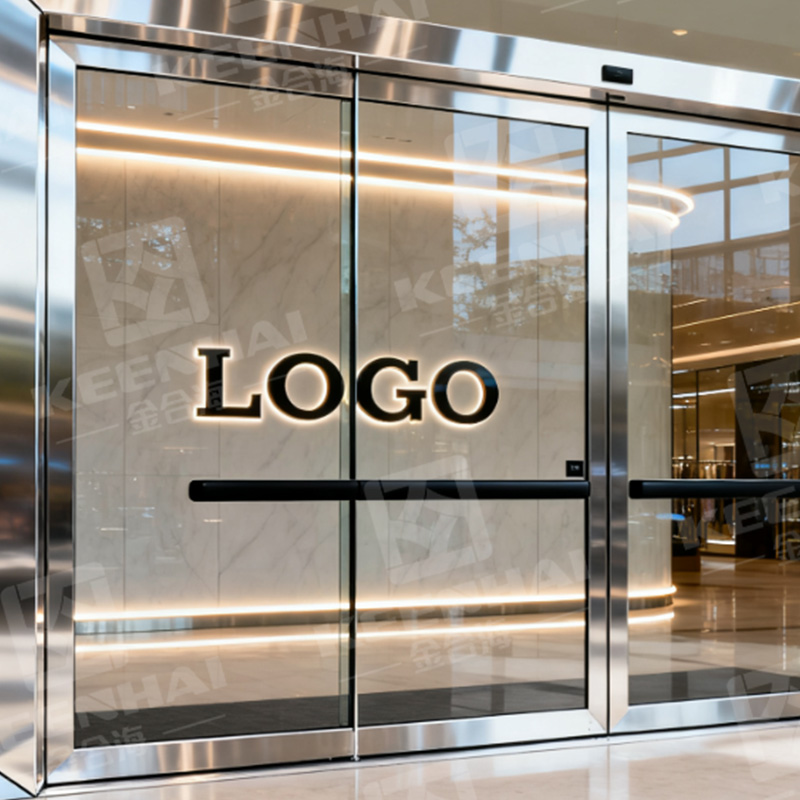PVD stainless steel sheet combines corrosion resistance and sleek finish, making elevator doors both durable and energy-efficient.
Durability and Strength
How Stainless Steel Resists Corrosion
Stainless steel stands out for its impressive ability to resist corrosion, thanks to a special combination of elements like chromium, nickel, and molybdenum. These elements form a thin, protective oxide layer on the surface of the steel, which acts as a shield against moisture, chemicals, and other corrosive factors. This layer is self-healing, meaning if it gets damaged, it can regenerate, keeping the material resistant to rust even when exposed to harsh environments.
In practical terms, stainless steel’s resistance to corrosion makes it a top choice for elevator door panels used in high-traffic areas and buildings with varying moisture levels, such as shopping malls or hospitals. For example, in coastal areas where the air is salty, stainless steel elevator doors will endure much longer than other metals. Studies show that hindi kinakalawang na asero can last anywhere from 50 to 100 years, even in these challenging conditions. This durability means fewer repairs, less maintenance, and a longer lifespan for elevator door products.
Stainless steel elevator door panels are durable and versatile, making them ideal for commercial and residential properties. Elevator door installation can benefit greatly from custom stainless steel doors with PVD coatings for a sleek finish.
On top of that, stainless steel doors won’t degrade when exposed to harsh cleaning chemicals or UV rays from the sun, which can break down other materials over time. This makes it a reliable option for buildings that require both functionality and aesthetic appeal without frequent replacements or repairs. You can explore more about these types of durable products at PVD Stainless Steel.
Longevity of Stainless Steel Elevator Doors in High-Traffic Areas
Stainless steel elevator doors shine when it comes to enduring heavy use in high-traffic buildings. These doors are designed to handle millions of open and close cycles without losing their structural integrity. In fact, stainless steel elevator doors can typically endure over 5 million open/close cycles before showing any noticeable wear or loss of performance. This makes them ideal for high-rise buildings, hotels, and other commercial spaces where elevators are constantly in operation.
For instance, in a busy office building or a shopping mall, the elevator doors may experience high-frequency use, often opening and closing hundreds of times each day. Despite this, the abrasion resistance of stainless steel ensures that even after years of constant use, the doors remain operational and visually intact. A comparison study between stainless steel elevator doors and aluminum ones showed that hindi kinakalawang na asero lasted up to 30% longer before needing any major repairs, demonstrating its superior resilience in high-traffic areas.
In addition to withstanding frequent cycles, stainless steel’s resistance to dents, scratches, and other physical damage ensures that the doors continue to look pristine even in busy environments. This makes it the go-to choice for buildings where appearance is just as important as performance. If you are looking for high-quality, durable elevator door panels, you can check out various options at PVD Stainless Steel.

Aesthetic na Apela
Sleek, Modern Look for Elevators
One of the primary reasons for choosing stainless steel for elevator doors is the sleek, modern look it offers. Stainless steel’s reflective surface creates a sophisticated and polished appearance, which is a major asset in high-end commercial buildings, luxury apartments, and office spaces. The material’s ability to maintain its finish over time ensures that the elevator doors remain stylish and visually appealing, even after years of use.
The clean lines and minimalist design inherent in stainless steel contribute to a contemporary feel that complements modern architecture. Stainless steel elevator doors are versatile enough to blend seamlessly with both industrial-style interiors and more polished, upscale spaces. Whether the goal is to highlight a modern, open-concept design or create a high-tech, futuristic environment, stainless steel serves as a perfect fit.
Another advantage of stainless steel’s visual appeal is its adaptability. It fits into various environments effortlessly—whether you’re designing a high-rise residential building, a shopping center, or a corporate office. The material is timeless, remaining relevant as architectural trends change. The natural finish of stainless steel also resists smudges and fingerprints, meaning the elevator doors stay visually appealing without constant cleaning. This makes stainless steel elevator doors the ideal choice for spaces that demand both form and function.
Customization Options for Various Building Designs
Stainless steel offers a wide range of mga pagpipilian sa pagpapasadya, allowing designers and architects to tailor the material to fit the specific needs of any building’s aesthetic. From the finish of the surface to the engraving and detailing, there are numerous ways to personalize stainless steel elevator doors to suit the look of a building.
For example, you can choose from various surface finishes like brushed, mirror, or matte to achieve different textures and visual effects. Mirror finishes are often chosen for high-end spaces, as they create a luxurious, polished look, while brushed finishes add a more subdued, industrial charm. There are also coloring options, such as PVD coating, which allows for metallic hues like gold, bronze, or black, providing even more design flexibility.
Additionally, architects can opt for custom engravings or designs on the doors, incorporating logos, brand names, or even artistic patterns. These details can align with a building’s branding or enhance its overall theme, making the elevator doors stand out as both functional and decorative features.
Custom-made stainless steel elevator doors are often built with specific dimensions to fit unique architectural layouts. Whether you’re working on a small boutique hotel or a large office complex, stainless steel provides the ability to create doors that perfectly match the structure’s size and proportions. At PVD Stainless Steel, you can explore various customization possibilities for your building’s elevator doors, ensuring they are both functional and aesthetically pleasing.

Maintenance and Cleaning
Easy to Clean Surfaces
Stainless steel is one of the easiest materials to clean, making it an ideal choice for elevator doors in high-traffic locations. The smooth, non-porous surface of stainless steel prevents dirt, dust, and stains from penetrating the material, making routine cleaning fast and effective. With a simple wipe-down using a soft cloth and a mild detergent, stainless steel elevator doors can maintain their gleaming appearance without much effort. This low-maintenance feature is especially beneficial in commercial and residential buildings where elevator doors are exposed to a variety of contaminants, from fingerprints to food and beverage spills.
To clean stainless steel elevator doors effectively, follow these steps:
-
Use a soft, lint-free cloth. Avoid using abrasive scrubbers, as they can scratch the surface.
-
Apply a mild detergent mixed with warm water to the cloth. For tough stains, a solution of water and vinegar can be effective.
-
Wipe the door in the direction of the grain. This keeps the surface looking uniform and polished.
-
Dry the surface with a clean cloth to prevent water spots and maintain the shine.
This simple process not only ensures that the surface remains clean but also reduces the chances of accumulating grime or oil, which can compromise the material’s appearance over time. According to studies, hindi kinakalawang na asero surfaces can be cleaned up to 50% faster than other materials, saving both time and labor costs in the long run. Stainless steel elevator door products remain visually appealing without requiring frequent touch-ups, allowing building managers to allocate resources elsewhere.
Low Maintenance Costs Over Time
The long-term maintenance costs of stainless steel elevator doors are significantly lower compared to other materials. Stainless steel is naturally resistant to corrosion, stains, and rust, meaning it requires less frequent replacement at fewer repairs over the lifespan of the elevator doors. In fact, a well-maintained stainless steel door can last up to 30% longer than doors made from other materials such as aluminum or wood, reducing the need for costly replacements and repairs.
Here’s why stainless steel elevator doors are so cost-effective:
-
tibay: Stainless steel can endure years of use without the wear and tear that often causes other materials to need replacement. A study by a major elevator manufacturer shows that hindi kinakalawang na asero can last up to 50 years with proper maintenance, compared to 15-20 years for other metals.
-
Paglaban sa Kaagnasan: The material’s inherent resistance to corrosion, especially in humid or salty environments, means it doesn’t require expensive anti-corrosion treatments. This feature reduces the need for repainting or refinishing, which are common in aluminum or steel doors that tend to rust over time.
-
Minimal Repair Costs: Since stainless steel is highly resistant to physical damage such as dents, scratches, and discoloration, the frequency of repairs is significantly reduced. For example, elevator doors in high-traffic buildings can be subject to millions of opening and closing cycles without losing their integrity, meaning that the repair costs associated with frequent servicing or part replacement are minimal.
Research also shows that the average cleaning and maintenance costs for stainless steel doors are about 20% lower annually compared to doors made from alternative materials like plastic or wood. This is because of the material’s ability to retain its appearance and performance with minimal upkeep. Over a 10-year period, you can expect to save between $500-$1,500 per door in maintenance costs when opting for stainless steel compared to other materials.
The long-term savings from reduced maintenance and extended service life make stainless steel a wise investment for any building. The initial cost might be higher, but the return on investment (ROI) is significantly better when considering the reduced frequency of repairs and replacements. With stainless steel, building owners and facility managers benefit from a product that performs well, looks good, and costs less to maintain over time.

Kahusayan ng Enerhiya
How Stainless Steel Contributes to Building Insulation
Stainless steel, although a metal, plays an important role in enhancing the kahusayan ng enerhiya of buildings, especially when used for elevator doors and other structural elements. One of the key advantages of stainless steel in energy efficiency lies in its thermal conductivity. Stainless steel has relatively low thermal conductivity compared to other metals like aluminum, meaning it resists heat transfer more effectively. This makes it a suitable material for reducing heat loss or heat gain through elevator shafts and entrances, especially in buildings with significant climate fluctuations.
Elevator doors made of hindi kinakalawang na asero act as an effective barrier between different temperature zones in a building. For instance, when installed in high-rise buildings, stainless steel doors can help maintain a consistent indoor temperature, reducing the load on HVAC systems. This is particularly useful in areas with extreme seasonal temperatures. A study found that stainless steel doors reduced the energy required for heating and cooling by up to 15% in buildings with frequent elevator use, compared to buildings with doors made of less insulating materials.
By preventing the rapid flow of heat through elevator shafts, stainless steel helps maintain energy-efficient climates in both commercial and residential buildings. This characteristic also reduces the need for constant temperature adjustments, further decreasing energy consumption. When combined with proper sealing techniques around elevator door frames, stainless steel elevator doors create an airtight seal that limits air exchange, improving insulation performance and contributing to overall building energy efficiency.
Energy-Saving Benefits of Stainless Steel Doors
The energy-saving benefits of stainless steel doors go beyond just insulation. Because stainless steel is durable and requires less maintenance, it ensures that energy systems work more efficiently by not requiring frequent repairs or replacements. A study by the American Society of Heating, Refrigerating and Air-Conditioning Engineers (ASHRAE) found that buildings equipped with high-performance stainless steel doors reported up to 10% savings in heating and cooling costs over a five-year period. This savings arises not only from the material’s natural insulating properties but also from its resistance to environmental wear, which keeps the door’s performance consistent throughout its lifespan.
Stainless steel’s inherent durability means that stainless steel elevator doors remain intact and energy-efficient for much longer than doors made from materials like wood or plastic, which can warp, crack, or degrade over time. For example, aluminum doors can experience thermal bridging, which means heat passes more easily through the material, forcing HVAC systems to work harder. Stainless steel, on the other hand, prevents this thermal bridging and helps maintain a more stable interior temperature. As a result, buildings with stainless steel doors experience lower HVAC usage, leading to reduced energy consumption at lower utility bills.
In commercial buildings, where energy costs can make up a significant portion of operating expenses, the installation of stainless steel elevator doors can be a valuable investment. Over a period of 5-10 years, the energy savings can amount to thousands of dollars, especially in buildings with high elevator traffic or those located in regions with extreme climates. For example, in a mid-sized office building, switching to energy-efficient stainless steel elevator doors can reduce the annual HVAC cost by $2,000-$5,000, depending on the size of the building and the frequency of elevator use.
By using stainless steel, building owners not only ensure the longevity and safety of their elevators but also contribute to the sustainability of their buildings by decreasing the overall energy footprint.
For buildings looking to combine durability, aesthetic appeal, and energy efficiency, stainless steel elevator door panels offer the perfect solution. These stainless steel elevator door panels not only provide long-lasting performance but also contribute to a building’s overall energy savings by improving insulation and reducing HVAC workload. Their sleek design, combined with low-maintenance requirements, makes them a smart choice for high-traffic areas in both commercial and residential buildings. Investing in stainless steel elevator door panels ensures a reliable and energy-efficient solution that stands the test of time.
Read more: What is a PVD stainless steel sheet?






